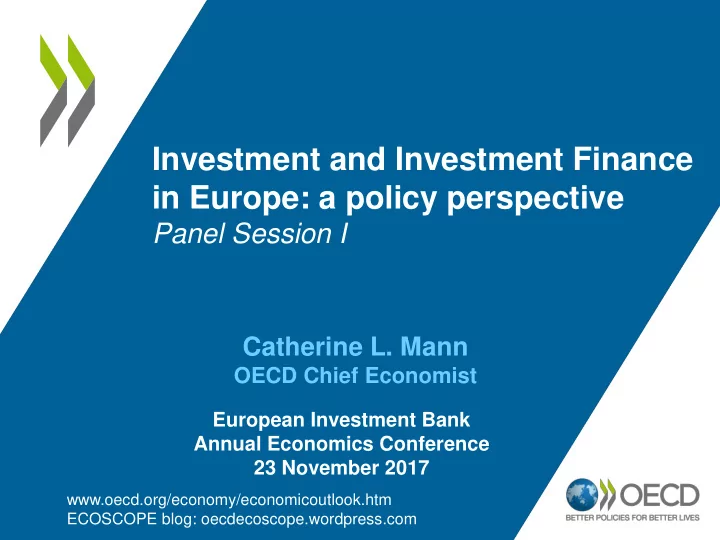

Investment and Investment Finance in Europe: a policy perspective Panel Session I Catherine L. Mann OECD Chief Economist European Investment Bank Annual Economics Conference 23 November 2017 www.oecd.org/economy/economicoutlook.htm ECOSCOPE blog: oecdecoscope.wordpress.com
Investment Recovering; Shortfalls Remain Structural factors inhibit, even as demand improves Investment shortfalls by country Non-residential investment, % of potential GDP Notes: RHS: Long-term needs are estimated following methodology of Lewis et al. (2014). 2 Source: OECD Economic Outlook database; and OECD calculations.
Credit is Flowing to Firms rise in debt-GDP in most countries offset by growth Decomposition of changes in non-financial corporations debt-to-GDP ratio 1 2007-2016 2007-2016 % of GDP % of GDP 100 100 GDP growth Net credit flows Other changes Change in debt 300 80 80 60 60 200 40 40 20 20 100 0 0 0 -20 -20 -40 -40 -100 IRL -60 -60 ESP DEU JPN NLD ITA GBR EA PRT USA GRC FRA CAN BEL 1. The change in debt-to-GDP ratio is decomposed according the formula: d(debt[t]) = -g(t)/(1+g[t])*debt[t-1] + net credit flows[t] = other changes[t], where g[t] is percentage nominal GDP growth (divided by 100), and the first term indicates the contribution of nominal GDP growth to debt dynamics. Other changes reflect changes due to write-offs, reclassification and revaluation. 3 Source: OECD, National Accounts database; and OECD calculations.
Role for Banking Union Discipline NPLs & Zombies; help improve dynamism Productivity gains from reducing zombie capital Average zombie firm share for each Gains to aggregate multi-factor productivity category of bank health Note: Firms aged 10 years or more and with profits not covering interest payments over Note: the average zombie firm share for each bin of bank health, purged of country- three consecutive years. The sample excludes firms that are larger than 100 times the industry-fixed effects. The relationship is statistically significant at the 1% level and is 99th percentile of the size distribution in terms of capital stock or number of employees. based on over 1.5 million firm-bank observations for 11 European countries over the Source: Adalet McGowan, Andrews and Millot (2017), “The Walking Dead? Zombie period 2001-2014. Firms and Productivity Performance in OECD Countries”, OECD Economics Source: Andrews, D. and F. Petroulakis (2017), “Breaking the Shackles: Zombie Firms, Department working paper; and OECD calculations. Weak Banks and Depressed Restructuring in Europe”, OECD Economics Department Working Papers. 4
Services harmonization would promote competitiveness, esp smaller firms Services trade restrictiveness indices The burden of restrictions falls 2016, covering 44 countries disproportionately on smaller firms Average Minimum Maximum 30 Cross-border trade 1.0 Foreign affiliate sales 25 0.8 0.6 20 Tariff equivalent in % 0.4 15 0.2 of STRI of 0.2 0.0 10 5 0 1 million 5 million 50 million 200 million Firm turnover in EUR Note: average effect across sectors and countries based on microdata from Belgium, Finland, Germany, Italy, Japan, the United Kingdom and the United States. The numbers indicate the ad Note: Covers the 35 OECD members plus Brazil, China, Colombia, Costa Rica, India, valorem tariff equivalent of an STRI score of 0.2 on top of what is incurred by firms with Indonesia, Lithuania, Russia and South Africa. turnovers of EUR 500m and above. Source: Rouzet, Benz and Spinelli (2017), “Trading Firms Source: OECD STRI database. and Trading Costs in Services”, OECD Trade Policy paper.
Role for Digital Single Market trade & investment potential inhibited by regulations More ‘connected’ countries sell more But cross-border data transfer restrictions products to more destinations (and local storage requirements) are rising 80 70 60 Nubmer of measures 50 Prohibition 40 Conditions - Combination 30 Conditional - One of 20 10 0 1983 1986 1989 1992 1995 1998 2001 2004 2007 2010 2013 Note: Figures show correlation between internet use per 100 inhabitants, number of products exported and export market. To avoid correlations arising through other variables, such as internet use and income, or number of products and size of markets, the residuals from a regression of the trade outcomes with respect to per capita GDP and size of markets with country specific fixed effects and time dummies are taken.
Monetary Policy Window for Fiscal Policy Governments are set to ease Government gross interest payments Fiscal stance is expected to ease Change in underlying primary balance, % of potential GDP have declined Average annual difference between 2011-14 and 2017-18 7 Note: LHS based on general government gross interest payments. Data for 2017-2018 are OECD projections. Source: OECD Economic Outlook database; and OECD calculations.
Use space for Fiscal-Structural initiatives to maximise impact on growth and inclusiveness Income of Countries with most Impact of spending reform Growth room for gains the poor CHL, GRC, MEX, Improving education PRT, TUR DEU, GBR, ITA, Increasing public investment MEX, TUR, USA and R&D FRA, GRC, HUN, Increasing government ITA, SVN effectiveness CHE, ESP, GRC, Increasing family benefits PRT, USA BEL, CHE Decreasing public subsidies positive impact uncertain or no impact Source: Based on Fournier and Johansson (2016), “The Effect of the Size and the Mix of Public Spending on Growth and 8 Inequality”, OECD Economics Department Working Papers, No. 1344, OECD Publishing, Paris.
Recommend
More recommend